This is a Veteran Owned site
![]()
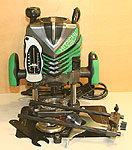 |
The new Hitachi M12V2 router expands on the previous version that was so popular with woodworkers. the new engineering and equipment make it an eve better value. Click image to enlarge |
Hitachi M12V2, 3 1/4Hp, Plunge Router
Big on power, features and value
Text & photos by Tom Hintz
New from Hitachi is the updated version of their venerable M12V router that has long been popular with woodworkers on a budget. The new Hitachi M12V2 brings an expanded set of features and equipment that make it an even better value.
Inside the Kit
Of particular interest to health-conscious users will be the built-in dust collection at the base. A shroud surrounds the bit opening, directing the debris into a positionable adapter that fits a 1 -¼”ID hose.
For guided routing the Hitachi M12V2 comes with a removable fence with micro-adjusting feature. It also includes a template adapter that fits Hitachi template guides and comes with one 5/8”ID by 23/32“OD guide and a nice ¼”-1/2” centering tool. An extra adapter is also included that fits the popular 1 ¼”-diameter Porter Cable-style guide collars and ring nuts.
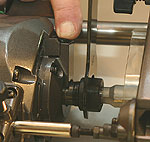 |
The pushbutton spindle lock makes changing bits a simple, one wrench job. Click image to enlarge |
Though ½”-shanked bits are the norm for big-horsepower routers, the Hitachi M12V2 also includes a ¼” collet and a collet wrench that fits collets.
Bit Changing
The Hitachi M12V2 uses a push button spindle lock that makes changing bits a one wrench job. Unlike some routers, the push button mechanism is easy to reach and use. The self-contained, self-extracting collets are well made and both screw onto the motor shaft without an adaptor. Openings between the plunge columns are large enough to provide easy access for the wrench, making loosening or tightening the collets a simple, knuckle-saving task.
Guide Templates
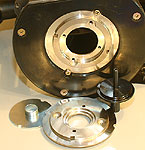 |
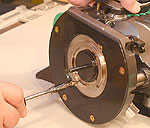 |
The template system includes (left) an adaptor for the popular Porter Cable-style guide collars. This system is made even better with the centering tool. (right) It is easy to use and very accurate. Click image to enlarge |
|
The template system included with the Hitachi M12V2 is rather unique because of the centering tool (also included in the kit) that is machined to fit the inside diameter of the template adaptor to which the individual templates are attached. Install the centering tool in the collet (it has ¼” and ½”-ends), engage the stepped flange in the template adaptor and tighten its screws.
This is an important feature, particularly when following smaller templates like those on dovetail jigs. If the template guide is slightly out of alignment with the bit centerline, the resulting joints will never be perfect.
The alignment tool also fits the included stepped template adaptor that allows use of the popular Porter Cable-style guide collars.
Controls
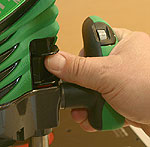 |
All of the controls are easy to reach and use. as on most routers, the speed control dial is marked with numeral positions only. Click image to enlarge |
The Hitachi M12V2 is equipped with an electronic, variable speed control with soft start, operated by a thumb wheel in the right handle. The wheel is marked with numerals from 1 to 6, breaking the 8,000 to 22,000 RPM range into equal segments. The speed dial does not have detents, making it infinitely adjustable.
The On/Off slider switch is built into the right side of the main housing and positioned so it can be reached without removing your hand from the handle. The On/Off switch is recessed and has a very positive feel that makes accidental startups almost difficult.
The plunge mechanism is locked and unlocked by a normal lever to the rear of the right handle. The lever is large enough to be operated easily and locks the plunge mechanism securely.
Depth Controls
 |
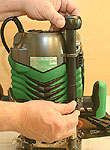 |
While the M12V2 has the traditional plunge rod and variable turret (left) it also has a nice fine height adjustment (right) that also works nicely in table-mounted situations. Click images to enlarge |
|
The Hitachi M12V2 has a conventional plunge rod and three position turret system that controls common routing depth changes. A finger-operated marker is used to establish “zero” and to quantify the amount of bit depth change. This marker interacts with dual metric/standard scales that makes using this feature simple regardless of your mathematical orientation.
On the rear of the Hitachi M12V2 is a fine-threaded rod that allows tiny, highly accurate bit height changes. A lever engages this system for use or disengages it when the plunge rod system is being used.
The rod can be operated with a finger knob or an included extension handle can be snapped into place that brings this adjustment above the top of the motor housing. This extension also makes adjusting bit height much easier when the Hitachi M12V2 is mounted under a router table. To make dedicated table use easier, the instructions describe removing the plunge springs.
In the Shop
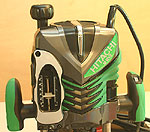 |
The styling of the H12V2 may be a bit outlandish for some but has nothing to do with how well this router works! Click image to enlarge |
Before the Hitachi M12V2 arrived, I had seen several forum posts knocking its appearance. They say beauty is in the eyes of the beholder and in this case, the list of beholders may be smaller than Hitachi anticipated. Every time I look at the Hitachi M12V2, thoughts of 1950’s era Pontiac hoods come to mind. I know someone in the design department worked hard on this but I also suspect they have had better efforts.
The good news is that nothing about the styling has anything to do with how this router performs. If your buying decisions are skewed heavily by appearance, the green and black avant-garde styling of the Hitachi M12V2 could be a problem. For the vast majority, outward appearances are a small factor compared to how the tool works.
All 3 ¼-Hp routers are large and the Hitachi M12V2 is no different. However, the design of the grips and its overall balance make it relatively nimble in the hand-held mode. With reasonably sized bits, the Hitachi M12V2 was very controllable in all of the hand operations we tried.
 |
 |
The dust collection (left) works rather well when connected to a good shop-vac or dust collector. The included fence system has a fine adjustment feature that works well. The fence is pre-drilled to make attaching wooden faces for specialty jobs simple. Click images to enlarge |
|
All of the controls worked as expected. The primary operating controls, plunge lock, speed control and On/Off switch are all easily reached. The one (small) negative is that the speed control dial is marked with numerals rather than the actual RPM they represent. There also is no chart in the instruction manual that explains the numeral/RPM relationship. To be fair, this is an industry-wide trend and certainly not exclusive to Hitachi products. Being an electronic control, it is safe to assume the changes are proportional, making each numeral represents a roughly 2000 rpm change.
The centering tool is easy to use and does a good job of aligning the template adaptor in the base. After using the alignment tool, we routinely found errors of 0.005” or less between the bit and guide collars, Hitachi and the Porter Cable styles.
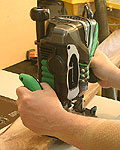 |
Though big on horsepower, the M12V2 is comfortable for many common hand-held operations. Click image to enlarge |
The power of the Hitachi M12V2 is more than ample for any reasonable routing task in the woodworking shop. Even large-diameter panel raising bits were driven easily through oak and maple, taking reasonably light cuts. There is power left to take cuts much deeper than anyone should.
The fine bit height adjustment and its extended knob are a very nice feature that make dialing in tiny bit height changes on the Hitachi M12V2 simple and very accurate. In a router table, you will be especially appreciative of this feature.
Right out of the box, the plunge mechanism was a little sticky. After wiping the columns down and applying a tiny amount of oil, that problem went away. The plunge controls work as well as any we have tried but the fine adjustment is what makes this a more accurate router to use.
Overall, the Hitachi M12V2 performed very well, made accurate cuts and was easy to set up to make them. It is surprisingly comfortable in the hand-held mode but is equally at home in a router table as well.
Conclusions
The Hitachi M12V2 is a solid router with features that enhance its power, making it useful for use in hand-held or table-mounted situations. With a street price of around $208.00 (7-2-2006) the Hitachi M12V2 kit, with the array of included components, is a very good value. For the home woodworking shop on a tight budget, the Hitachi M12V2 may be your best way to bring big router power to your work without overstressing the pocketbook.
Do you have a comment on this review? –Email Me!
All written, photographic and drawn materials are property of and copyright by NewWoodworker.com LLC 2000-2019. Materials may not be used in any way without the written permission of the owner.
